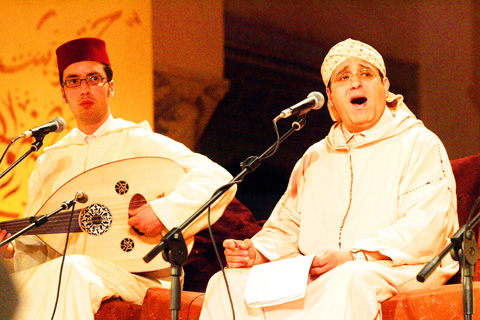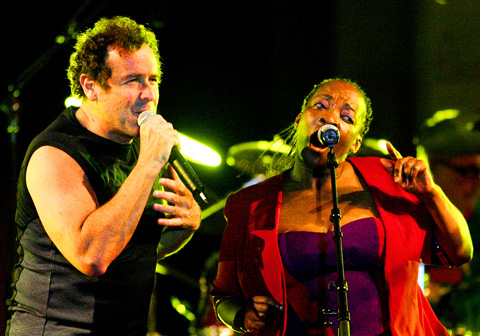Against the magnificent backdrop of the keyhole gate to the royal palace in Fez, Morocco, Youssou N’Dour gave the live premiere of Egypt, his most groundbreaking album in years. With Egyptian strings and Senegalese percussion, his incantatory voice soared into the warm night sky. The album is about Islam, the Mouride brotherhoods of his native Senegal and their message of peace. The occasion was the Fez Festival of World Sacred Music in Morocco (this year’s event runs from June 6 to June 15, fesfestival.com), and the shrine of one of the saints he was singing about was just a few minutes away in the labyrinth of lanes that form the medina.
get juxtaposed
Music festivals have mushroomed. There are those, like Exit in Serbia or Benicassim in Spain, that give you pop and rock stars, indie bands and DJs, but the ones I prefer are those that spring from their location and give you a window on the culture.

PHOTO: AFP
Fez is the artistic and spiritual capital of Morocco. It’s a glorious city in its own right, with a mosque and university dating back to the 9th century. All roads lead to the Kairaouine mosque and shrine of Moulay Idriss II in the heart of the medina, and en route you can enjoy getting lost in the best-preserved medieval Arabic city in the world. There are leather-workers, tailors, carpenters, donkeys laden with mint and piles of olives and fruit. You are bombarded with colors, smells and, during the festival, a glorious variety of music.
The festival was started as a reaction against the polarization of the Arabic world and the West. The idea is simple: to juxtapose sacred music of all cultures and religions. These take place in atmospheric venues like the huge Bab Makina (where Youssou performed), the intimate garden of the Batha Museum, free concerts in the city and late-night Sufi groups in a tiled garden pavilion. Non-Muslims are not allowed into mosques and shrines in Morocco, so it’s a great way to get a taste of the thrilling sounds of Islamic Sufi music — very strong in Morocco — and mix with the locals.
An excuse to travel

PHOTO: AFP
Perhaps the festival of this kind that has most successfully captured people’s imagination is the Festival in the Desert — deep in the Sahara beyond Timbuktu in Mali (festival-au-desert.org, Jan. 8, 2009 to Jan. 10, 2009). Its cult status comes from the almost mythical status of Timbuktu, its inaccessibility and the fantastic music that’s played there — the late Ali Farka Toure and Touareg rockers Tinariwen have played there. The fact that Robert Plant, Manu Chao and Damon Albarn have also made the journey has given it added kudos. But Mali has another one to offer — the Festival on the Niger in the pleasant riverside town of Segou (festivalsegou.org, Jan. 29, 2009 to Feb. 1, 2009). It’s much easier to reach and very laidback. Segou, on the banks of the river Niger, is the old capital of the Bambara kingdom and is reinventing itself as a center for the visual arts and crafts. There are puppet shows — a local tradition — alongside dance and music. In a location like this, the music and the society that produces it start to fall into place. Scheduled for next year are Salif Keita, Bassekou Kouyate, the excellent local band Super Biton de Segou plus musicians from Guinea and Mexico.
With many of these festivals, music isn’t the reason but the excuse to travel. Around the world, music is a socializing force and something that enriches the travel experience. Mostar in Bosnia Herzegovina, with its famous bridge, is one of the jewels of the Balkans, but often just visited on a day trip from Dubrovnik. But stay a few days during the Mostar World Music Festival (Aug. 5 to Aug. 7, worldmusic.ba), hang out on the shady terraces with grilled meat and local wine, and you start to get a deeper insight into the Bosnian, Croatian and Serbian mix of this town, which they never believed could be torn apart by war.
The Old Bridge, built by the Turks in the 16th century, was destroyed by shelling in 1993, but has now been meticulously reconstructed with stones from the original quarry. Similarly, sevdah, the music popularized by Mostar Sevdah Reunion, has Turkish roots but is now accompanied by clarinet, accordion and guitar and suffused with Balkan longing. Heard on the banks of the Neretva river beneath the bridge, it’s music that makes sense of the location but is also helping to unify a city that is still ethnically divided.

PHOTO: AFP
Support for local art
It’s often the combination of a great location, spectacular performance spaces and the right music that makes a festival work. For that it’s hard to beat the new Jodhpur International Folk Festival (JIFF) in Rajasthan, which had its first edition in October last year (jodhpurfolkfestival.org, Oct. 10 to Oct. 14). It’s held in the halls, courtyards and ramparts of the Maharaja’s Mehrangarh Fort, magnificently situated on a rocky outcrop overlooking the city. The opening is timed to coincide with the full moon and involves vivid costumes, dancing, processions, camels, flaming torches and some of the wildest and most exciting music on the planet.
Mick Jagger, who’s presumably got a few rock festivals under his belt, was there — not as a performer, but a punter. “I listen to a lot of Indian music,” he said, “and a festival like this gives a great platform to folk artists.” More than that, it is helping to sustain local musicians in Rajasthan, bringing an income and respect to highly skilled performers who are often marginalized in India’s economic boom. Festivals like these enable you to experience great music where it belongs — alongside the food and the people. If you listen and share people’s music, it’s like sharing a little of their soul.

Nov. 11 to Nov. 17 People may call Taipei a “living hell for pedestrians,” but back in the 1960s and 1970s, citizens were even discouraged from crossing major roads on foot. And there weren’t crosswalks or pedestrian signals at busy intersections. A 1978 editorial in the China Times (中國時報) reflected the government’s car-centric attitude: “Pedestrians too often risk their lives to compete with vehicles over road use instead of using an overpass. If they get hit by a car, who can they blame?” Taipei’s car traffic was growing exponentially during the 1960s, and along with it the frequency of accidents. The policy

Hourglass-shaped sex toys casually glide along a conveyor belt through an airy new store in Tokyo, the latest attempt by Japanese manufacturer Tenga to sell adult products without the shame that is often attached. At first glance it’s not even obvious that the sleek, colorful products on display are Japan’s favorite sex toys for men, but the store has drawn a stream of couples and tourists since opening this year. “Its openness surprised me,” said customer Masafumi Kawasaki, 45, “and made me a bit embarrassed that I’d had a ‘naughty’ image” of the company. I might have thought this was some kind

What first caught my eye when I entered the 921 Earthquake Museum was a yellow band running at an angle across the floor toward a pile of exposed soil. This marks the line where, in the early morning hours of Sept. 21, 1999, a massive magnitude 7.3 earthquake raised the earth over two meters along one side of the Chelungpu Fault (車籠埔斷層). The museum’s first gallery, named after this fault, takes visitors on a journey along its length, from the spot right in front of them, where the uplift is visible in the exposed soil, all the way to the farthest

The room glows vibrant pink, the floor flooded with hundreds of tiny pink marbles. As I approach the two chairs and a plush baroque sofa of matching fuchsia, what at first appears to be a scene of domestic bliss reveals itself to be anything but as gnarled metal nails and sharp spikes protrude from the cushions. An eerie cutout of a woman recoils into the armrest. This mixed-media installation captures generations of female anguish in Yun Suknam’s native South Korea, reflecting her observations and lived experience of the subjugated and serviceable housewife. The marbles are the mother’s sweat and tears,